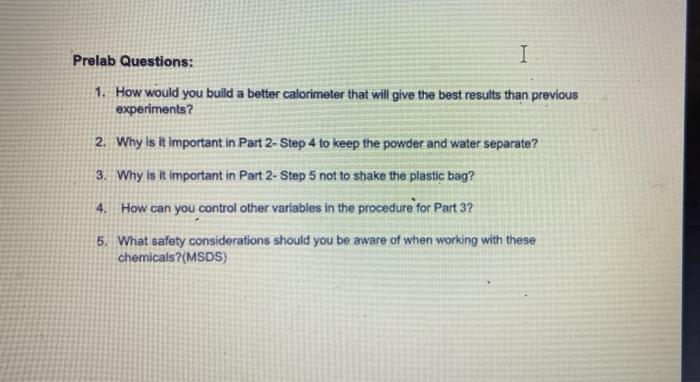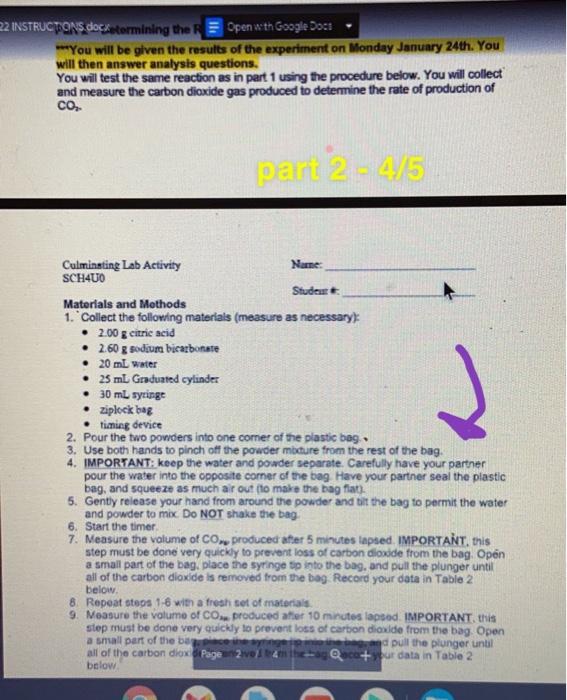Prelab Questions: I 1. How would you build a better calorimeter that will give the best results than previous experiments ? 2. Why is it important in Part 2-Step 4 to keep the powder and water separate? 3. Why is it important in Part 2-Step 5 not to shake the plastic bag? 4. How can you control other variables in the procedure for Part 3? 5. What safety considerations should you be aware of when working with these chemicals?(MSDS) 10 Part 3: Optimizing Production You will test the same reaction as in parts 1 and 2. However, you will use different amounts of citric acid and sodium bicarbonate. By collecting data using different amounts of citric acid, you will be able to optimize the reaction, or design the reaction to create the most profit. Part 3 Procedures 1. Collect the following materials (measure as necessary): 10 g citric acid 20 g sodium bicarbonate water ziplock bag thermometer digital/analog) syringe other materials (online) 2. Design an experiment using the materials in step #1 that will allow you to optimize the reaction by producing the greatest amount of carbon dioxide and minimize the waste of the reactants. HINT: You should set up multiple trails to compare carbon dioxide production using various ratios of reactants Culminating Lab Activity Nane SCH400 Student 3. You experimental design should include: hypothesis, variables (independent, dependent and controlled variables), materials, detalled procedure, expected results, analysis methods, identifying sources of error "AXYou will design an experiment that would optimize the production of trisodium citrate. You will NOT conduct the experiment. ***You have the option to communicate your experimental design in a conversation OR in an alternative format examples slides video, report, etc.). Page 2 Q + Part 4: Physical and che 22 INSTRUCTIONS.docxetermining the R Open with Google Docs You will be given the results of the experiment on Monday January 24th. You will then answer analysis questions. You will test the same reaction as in part 1 using the procedure below. You will collect and measure the carbon dioxide gas produced to determine the rate of production of CO, part 2 - 4/5 Culminating Lab Activity Nume: SCH4U0 Student Materials and Methods 1. Collect the following materials (measure as necessary} 2.00 g citric acid 260 g sodium bicarbonate 20 ml water 25 mL Graduated cylinder 30 mL syringe ziplock bag timing device 2. Pour the two powders into one come of the plastic bag. 3. Use both hands to pinch off the powder micture from the rest of the bag. 4. IMPORTANT: keep the water and powder separate. Carefully have your partner pour the water into the opposite comer of the bag Have your partner seal the plastic bag, and squeeze as much air out to make the bag fiat). 5. Gently release your hand from around the powder and tilt the bag to permit the water and powder to mix Do NOT shake the bag 6. Start the timer 7. Measure the volume of Cow produced after 5 minutes lapsed. IMPORTANT, this step must be done very quickly to prevent loss of carbon dioxide from the bag Open a small part of the bag, place the syringe tip into the bag, and pull the plunger until all of the carbon dioxide is removed from the bag Record your data in Table 2 below. 8. Repeat steps 1-6 with a fresh set of materials 9. Measure the volume of CO... produced after 10 minutes lapsed. IMPORTANT. this stop must be done very quickly to prevent loss of carbon dioxide from the bag Open a small part of the bar and pull the plunger until all of the carbon dioxd Page cetur data in Table 2 below









